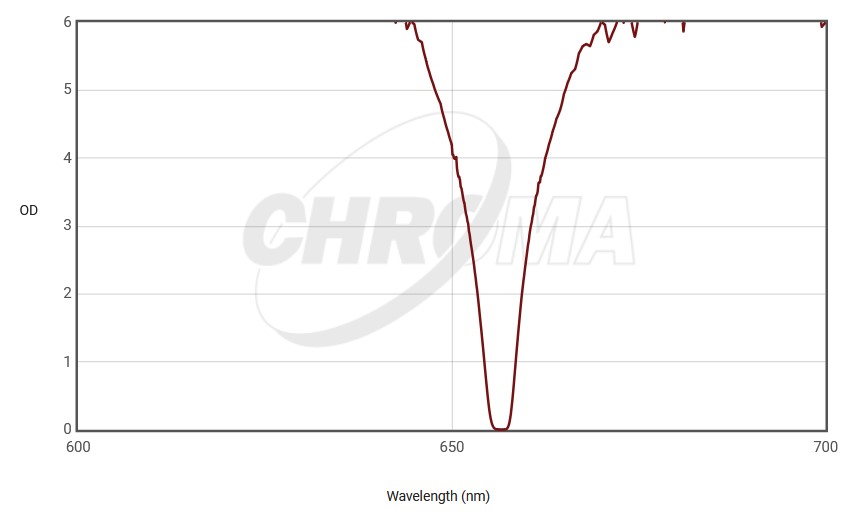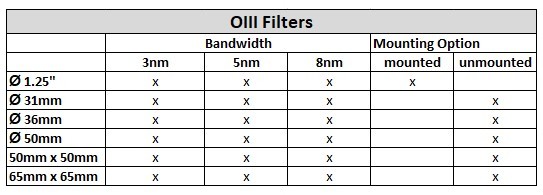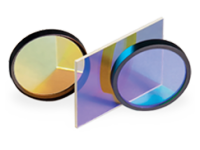
Chroma Narrowband Filters with 3nm, 5nm and 8nm Bandwidth
These nebula filters from Chroma offer extreme contrast. Thus, the astrophotographer achieves a very good result even with considerable stray light from cities or from the moon. The high transmission is given up to a focal ratio of f/4.
The quality features of these narrow band filters
- High light transmission and narrow bandwidth to maximise contrast
- Use in light sensitive areas and dark locations
- Extends exposure time under moonlight conditions
- These narrow-band filters can be used up to f/4 with virtually no loss of signal.
- Blackened edges to prevent internal stray light reflections
- Consistent 3.0mm filter thickness ensures parfocality
H-Alpha Filters
H-alpha filters can only be used photographically, but objects emit about three times as much at this wavelength as they do at H-beta. H-alpha filters are essential for imaging nebulae and other objects which are rich in ionized hydrogen. At 656.3nm, a narrow-band emission filter is required to separate H-alpha from the SII doublet (671.6nm and 673.1nm).


H-Alpha: All transmission and blocking (OD) data are actual, measured spectra of representative production lots. Spectra varies slightly from lot to lot. Optical density values in excess of 6 may appear noisy because such evaluations push the resolution limit of low light level measurements.
Filter variants:
H-alpha 3nm Bandpass optimized for f/2.8-f/3.6
H-alpha filters are essential for imaging nebulae and other objects which are rich in ionized hydrogen. At 656.3nm, a narrow-band emission filter is required to separate H-alpha from the SII doublet (671.6nm and 673.1nm). Chroma’s f/3.0 filters are designed to minimize spectral shift and hold their shape better in an f/3.0 beam.


All transmission and blocking (OD) data are actual, measured spectra of representative production lots. Spectra varies slightly from lot to lot. Optical density values in excess of 6 may appear noisy because such evaluations push the resolution limit of low light level measurements.
H-Beta Filters
H-beta filters are also useful for imaging nebulae and objects rich in ionized hydrogen. At 486.1nm, a narrow-band filter is required to separate H-beta from nearby blue and green spectral lines. Although weaker than the H-alpha line, this is often used for visual detection as the longer red wavelengths of H-alpha are difficult to detect by eye.



All transmission and blocking (OD) data are actual, measured spectra of representative production lots. Spectra varies slightly from lot to lot. Optical density values in excess of 6 may appear noisy because such evaluations push the resolution limit of low light level measurements.
OIII Filters
Chroma’s OIII filters isolate the 500.7nm primary emission line of doubly ionized oxygen. After H-alpha, this is the next most common emission when imaging nebulae



All transmission and blocking (OD) data are actual, measured spectra of representative production lots. Spectra varies slightly from lot to lot. Optical density values in excess of 6 may appear noisy because such evaluations push the resolution limit of low light level measurements.
Filter variants:
OIII 3nm Bandpass optimized for f/2.8-f/3.6
Chroma’s OIII filters isolate the 500.7nm primary emission line of doubly ionized oxygen. After H-alpha, this is the next most common emission when imaging nebulae. Chroma’s f/3.0 filters are designed to minimize spectral shift and hold their shape better in an f/3.0 beam.


All transmission and blocking (OD) data are actual, measured spectra of representative production lots. Spectra varies slightly from lot to lot. Optical density values in excess of 6 may appear noisy because such evaluations push the resolution limit of low light level measurements.
SII-Filters
SII filters isolate the spectral emission of singly ionized sulfur atoms, also common in nebulae. Emission is at two lines occurring as a doublet, at 671.6 and 673.1 nm. This filter also separates sulfur emission from H-alpha emission (656.3nm).



All transmission and blocking (OD) data are actual, measured spectra of representative production lots. Spectra varies slightly from lot to lot. Optical density values in excess of 6 may appear noisy because such evaluations push the resolution limit of low light level measurements.
Filter variants:
SII 3nm Bandpass optimized for f/2.8-f/3.6
SII filters isolate the spectral emission of singly ionized sulfur atoms, also common in nebulae. Emission is at two lines occurring as a doublet, at 671.6 and 673.1 nm. This filter also separates sulfur emission from H-alpha emission (656.3nm). Chroma’s f/3.0 filters are designed to minimize spectral shift and hold their shape better in an f/3.0 beam.


All transmission and blocking (OD) data are actual, measured spectra of representative production lots. Spectra varies slightly from lot to lot. Optical density values in excess of 6 may appear noisy because such evaluations push the resolution limit of low light level measurements.
Jovian Methane
Methane absorption band filter. This filter enhances contrast when imaging objects containing significant levels of methane. Methane-rich components, such as in the atmosphere of the Jovian planets, will appear darker.



All transmission and blocking (OD) data are actual, measured spectra of representative production lots. Spectra varies slightly from lot to lot. Optical density values in excess of 6 may appear noisy because such evaluations push the resolution limit of low light level measurements.
LoGlow Light Pollution
Blocks common spectral lines from lighting sources. This filter provides balanced color for the visible spectrum while blocking most emission from metal-halide and vapor lamp sources which together contribute to sky glow.



All transmission and blocking (OD) data are actual, measured spectra of representative production lots. Spectra varies slightly from lot to lot. Optical density values in excess of 6 may appear noisy because such evaluations push the resolution limit of low light level measurements.










